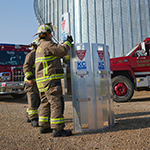Grain quality and personal safety go hand in hand
Enhanced grain quality management can help improve worker safety.
Courtesy of the Agricultural and Biosystems Engineering Department at Iowa State University, this article details the association between high-quality grain and improved worker safety.
Prudent post-harvest management of grain prevents spoilage, preserves quality attributes and establishes market value. However, preserving the quality of grain also has implications for safety.
Low-quality grain is characterized by high levels of moisture, damage and foreign material. Low-quality grain flows poorly, creating clogs and stressing equipment, which in turn may encourage unsafe actions or shortcuts in the interest of saving time.
Additionally, poor equipment maintenance or inadequate handling capacity can be worsened by low-quality grain, resulting in breakdowns at inopportune times. Furthermore, because grain quality directly impacts the market value of the product, the push to move quickly and optimize efficiency often means that personal safety is sacrificed.
Rain, snow and other extreme weather conditions negatively impact quality, creating additional operator stress that can lead to further safety shortcuts. Unexpected snow is a particular culprit in these situations. Pre-harvest planning for “what-if” scenarios can pay big rewards in both inventory control and personal stress/accidents.
One clear example of the association between quality and safety is with grain moisture content. Although not a quality grading factor, moisture content plays an important role in quality management. Storage and management strategies for grain are largely determined by moisture levels. High-moisture grain cannot be marketed through normal channels without extensive drying. High moisture levels may limit handling, storage and feeding options.
In years when grain is wet, worker engulfments generally increase. As dryer capacity falls behind, high-moisture grain ends up in storage, with higher risk of spoilage, which in turn creates safety hazards for workers who handle grain. Spoiled grain is unstable and can bridge, forming a grain pile that appears to be solid, but is not. Experience in previous wet harvest years indicates that delaying harvest, as long as stalk strength is good, will be better for both quality and safety than overloading of drying and aeration systems.
When delaying harvest is not possible, other mitigation strategies can be utilized. Removing the center core will also reduce grain flow issues and lower the need to enter the bin. The center cores are usually higher in foreign material that is wetter and more difficult to move. At the same time airflow distribution is greatly improved.
The association between high quality grain and improved worker safety outcomes has been demonstrated in multiple research studies. In examining confined space engulfment incidents occurring from 1964 to 2010, out-of-condition grain was reported to be the primary cause for the majority of incidents. Tasks such as handling out-of-tolerance products, corrective actions, critical storage decisions and appropriate action points have important implications for both grain quality and human safety.
Enhanced quality management can improve marketability of your crop, but to realize these benefits you must be pro-active with safety as well. When human actions result in poor management of quality, safety hazards often emerge. Keeping both safety and quality in mind will generate benefits to your personal safety, as well as your bottom line.
For more information on this topic, please contact:
Dr. Charles R. Hurburgh
Professor, Agricultural and Biosystems Engineering
Professor in Charge, Iowa Grain Quality Initiative
3167 NSRIC
1029 N. University Blvd.
Iowa State University
Ames, IA 50011
(515) 294-8629
tatry@iastate.edu
Gretchen A. Mosher, PhD
Assistant Professor, Agricultural and Biosystems Engineering
605 Bissel Road, 3331 Elings Hall
Iowa State University
Ames, IA 50011
(515) 294-6416
gamosher@iastate.edu
© Iowa State University. Used with permission.

 >
>

 >
>
 >
>